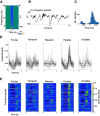Human Spindle Variability
- PMID: 35477906
- PMCID: PMC9172080
- DOI: 10.1523/JNEUROSCI.1786-21.2022
Human Spindle Variability
Abstract
In humans, sleep spindles are 10- to 16-Hz oscillations lasting approximately 0.5-2 s. Spindles, along with cortical slow oscillations, may facilitate memory consolidation by enabling synaptic plasticity. Early recordings of spindles at the scalp found anterior channels had overall slower frequency than central-posterior channels. This robust, topographical finding led to dichotomizing spindles as "slow" versus "fast," modeled as two distinct spindle generators in frontal versus posterior cortex. Using a large dataset of intracranial stereoelectroencephalographic (sEEG) recordings from 20 patients (13 female, 7 male) and 365 bipolar recordings, we show that the difference in spindle frequency between frontal and parietal channels is comparable to the variability in spindle frequency within the course of individual spindles, across different spindles recorded by a given site, and across sites within a given region. Thus, fast and slow spindles only capture average differences that obscure a much larger underlying overlap in frequency. Furthermore, differences in mean frequency are only one of several ways that spindles differ. For example, compared with parietal, frontal spindles are smaller, tend to occur after parietal when both are engaged, and show a larger decrease in frequency within-spindles. However, frontal and parietal spindles are similar in being longer, less variable, and more widespread than occipital, temporal, and Rolandic spindles. These characteristics are accentuated in spindles which are highly phase-locked to posterior hippocampal spindles. We propose that rather than a strict parietal-fast/frontal-slow dichotomy, spindles differ continuously and quasi-independently in multiple dimensions, with variability due about equally to within-spindle, within-region, and between-region factors.SIGNIFICANCE STATEMENT Sleep spindles are 10- to 16-Hz neural oscillations generated by cortico-thalamic circuits that promote memory consolidation. Spindles are often dichotomized into slow-anterior and fast-posterior categories for cognitive and clinical studies. Here, we show that the anterior-posterior difference in spindle frequency is comparable to that observed between different cycles of individual spindles, between spindles from a given site, or from different sites within a region. Further, we show that spindles vary on other dimensions such as duration, amplitude, spread, primacy and consistency, and that these multiple dimensions vary continuously and largely independently across cortical regions. These findings suggest that multiple continuous variables rather than a strict frequency dichotomy may be more useful biomarkers for memory consolidation or psychiatric disorders.
Keywords: cortex; hippocampus; intracranial; sleep; slow oscillation; spindle.
Copyright © 2022 the authors.
Figures









References
-
- Ameijeiras-Alonso J, Crujeiras RM, Rodriguez-Casal A (2021) multimode: An R Package for Mode Assessment. J Stat Softw 97:1–32.
-
- Anderer P, Klösch G, Gruber G, Trenker E, Pascual-Marqui RD, Zeitlhofer J, Barbanoj MJ, Rappelsberger P, Saletu B (2001) Low-resolution brain electromagnetic tomography revealed simultaneously active frontal and parietal sleep spindle sources in the human cortex. Neuroscience 103:581–592. 10.1016/S0306-4522(01)00028-8 - DOI - PubMed
-
- Ayoub A, Aumann D, Hörschelmann A, Kouchekmanesch A, Paul P, Born J, Marshall L (2013) Differential effects on fast and slow spindle activity, and the sleep slow oscillation in humans with carbamazepine and flunarizine to antagonize voltage-dependent Na+ and Ca2+ channel activity. Sleep 36:905–911. 10.5665/sleep.2722 - DOI - PMC - PubMed
